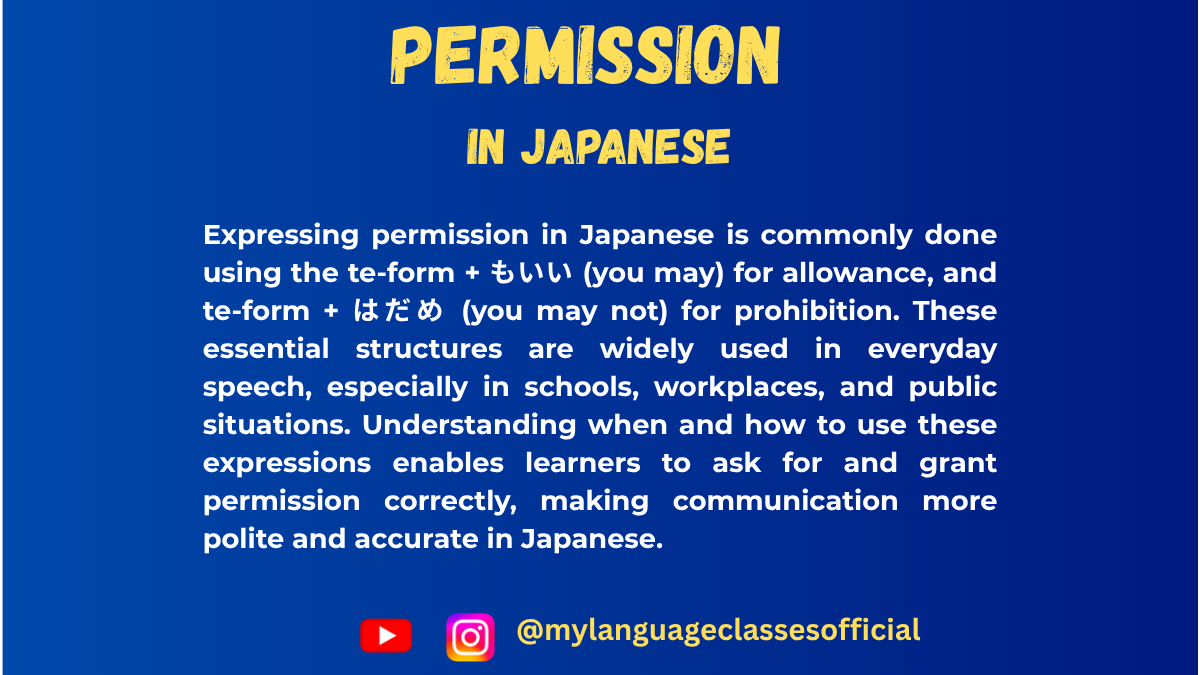Your cart is currently empty!
Tag: English grammar
-

How to Use かもしれない | My Language Classes
Expressing Possibility in Japanese: かもしれない
When learning Japanese, understanding how to express possibility or uncertainty is essential for nuanced communication. The phrase かもしれない (かも) is a versatile and frequently used expression in Japanese to indicate that something “might” happen or “could” be the case. In this blog post, we will delve deeply into the usage of かもしれない, including its grammatical structure, variations, and common situations where it is used.
What Does かもしれない Mean?
かもしれない literally translates to “might” or “could,” expressing a sense of possibility or uncertainty about a situation. It is often used when the speaker is unsure about the likelihood of an event or fact but wants to acknowledge its potentiality.
Variations in Formality:
- Casual: かもしれない
- Polite: かもしれません
- Abbreviated (Casual Speech): かも
- Example: これは大変かも。 (This could be serious.)
Grammatical Structure
かもしれない follows directly after a predicate and can attach to various parts of speech:
- Nouns:
- Structure: [Noun] + かもしれない
- Example: これはプレゼントかもしれない。 (This might be a present.)
- Adjectives (i-adjectives):
- Structure: [i-adjective] + かもしれない
- Example: あの店は高いかもしれない。 (That shop might be expensive.)
- Adjectives (na-adjectives):
- Structure: [na-adjective] + だ + かもしれない
- Example: この話は大事だかもしれない。 (This story might be important.)
- Verbs:
- Structure: [Verb (plain form)] + かもしれない
- Example: かれは来るかもしれない。 (He might come.)
Key Points to Remember
- Degree of Possibility: かもしれない implies a low to moderate degree of certainty. It’s not used for highly probable events.
- Uncertainty Tone: This expression adds a soft, non-committal tone to statements, making it useful in conversations where certainty is lacking.
- Position in Sentence:
- Always follows the predicate directly.
- Cannot be used at the start of a sentence.
- Politeness: Use かもしれません in formal situations or when speaking to superiors.
Common Situations to Use かもしれない
Here are some typical scenarios where かもしれない is used:
1. Guessing About Someone’s Actions:
- 他は明日会社に来ないかもしれない。
(He might not come to the office tomorrow.)
2. Weather Predictions:
- 今夜は雨が降るかもしれない。
(It might rain tonight.)
3. Speculating About the Past:
- 他はこのテストに落ちたかもしれない。
(He might have failed this test.)
4. Expressing Caution:
- その道は危ないかもしれない。
(That path might be dangerous.)
5. Making Suggestions With Hesitation:
- これを使ったら良い結果がでるかもしれない。
(Using this might give good results.)
6. Talking About Plans:
- 私は今年日本へ行くかもしれない。
(I might go to Japan this year.)
7. Health Concerns:
- あなたは病気になりかけているかもしれない。
(You might be getting sick.)
Practical Notes on Usage
- Avoid Overuse: While かもしれない is useful, overusing it can make your statements seem overly speculative.
- Alternative Phrases:
- Instead of かもしれない, consider using 可能性がある (かのうせいがある, “there is a possibility”) for more formal contexts.
- Context Matters:
- Use かもしれない sparingly in professional or serious settings where certainty is preferred.
Practice Exercise
Complete the following sentences with かもしれない:
- 今日はカラオケが出る…。
(It might snow today.) - あの人はこの仕事をキャンセルする…。
(That person might cancel this task.) - この商品は新品じゃない…。
(This product might not be new.)
Conclusion
かもしれない is a subtle yet powerful expression for conveying possibility and uncertainty in Japanese. By mastering its usage, you can add nuance to your conversations and sound more natural when speaking Japanese. Practice using it in different scenarios, and you’ll find it becoming a natural part of your language toolbox!
If you enjoyed this lesson, be sure to check out more posts like this on my blog at My Language Classes. Don’t forget to subscribe my YouTube channel and follow me on Instagram for the latest language learning tips and lessons. Leave a comment below to share your thoughts, or ask any questions you have about nouns.
Happy learning! 😊
-
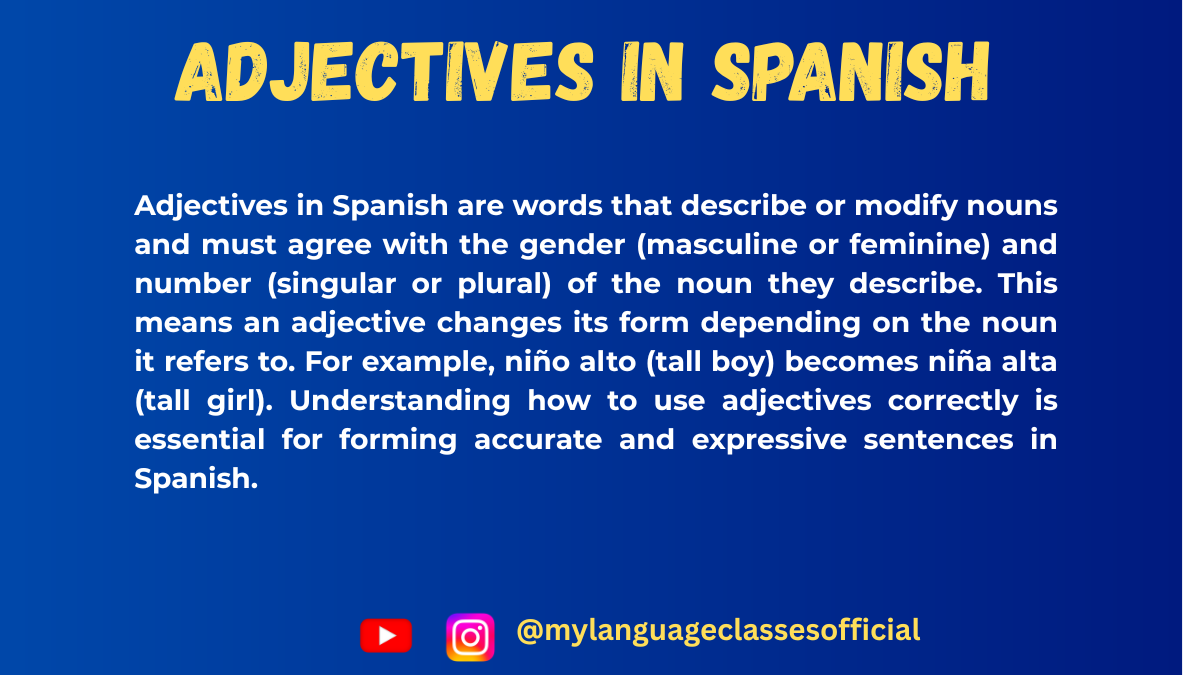
Adjectives in Spanish
Learning Spanish is a rewarding journey, and understanding the agreement and placement of adjectives is a key step in mastering the language. Unlike in English, where adjectives are generally static in form and placement, Spanish adjectives change depending on gender, number, and often their position within a sentence. Let’s dive into the rules and nuances of this fundamental grammar topic.
1. Adjective Agreement: Gender and Number
In Spanish, adjectives must agree in gender (masculine or feminine) and number (singular or plural) with the noun they describe. Here’s how:
Gender Agreement
- Masculine singular nouns take adjectives ending in “-o”.
- Example: un libro interesante (an interesting book)
- un libro rojo (a red book)
- Feminine singular nouns take adjectives ending in “-a”.
- Example: una casa bonita (a beautiful house)
- una chica inteligente (a smart girl)
- Adjectives that end in “-e” or a consonant do not change for gender.
- Example: un estudiante amable (a kind student, masculine)
- una estudiante amable (a kind student, feminine)
Number Agreement
- To make adjectives plural:
- Add -s if the adjective ends in a vowel.
- Example: chico simpático → chicos simpáticos
- Add -es if the adjective ends in a consonant.
- Example: mujer feliz → mujeres felices
- Add -s if the adjective ends in a vowel.
2. Placement of Adjectives: Before or After the Noun?
Unlike English, where adjectives almost always precede the noun, Spanish allows adjectives to appear both before and after the noun, depending on the type of adjective and the meaning.
Adjectives that Generally Follow the Noun
Most descriptive adjectives follow the noun:
- Example: una flor hermosa (a beautiful flower)
- un coche nuevo (a new car)
Adjectives that Precede the Noun
Certain adjectives, especially those indicating quantity, order, or inherent qualities, come before the noun:
- Example: muchos amigos (many friends)
- primer día (first day)
- la blanca nieve (the white snow; “white” is a poetic or inherent quality here)
Adjective Placement and Meaning
Some adjectives change their meaning depending on placement:
- Example: un hombre grande (a big man) vs. un gran hombre (a great man)
- una mujer pobre (a poor woman, economically) vs. una pobre mujer (a pitiable woman)
3. Articles and Adjectives
Adjectives in Spanish often work closely with definite (el, la, los, las) or indefinite articles (un, una, unos, unas). Keep these rules in mind:
- The article must match the noun in gender and number.
- Example: el chico alto (the tall boy)
- las chicas altas (the tall girls)
- When using more than one adjective, ensure both agree with the noun:
- Example: un perro grande y amistoso (a big and friendly dog)
- unas casas bonitas y cómodas (some beautiful and comfortable houses)
4. Common Exceptions and Tips
Invariable Adjectives
Some adjectives, particularly those borrowed from other languages (like beige or naranja), do not change form for gender or number.
- Example: unos sofás beige (some beige sofas)
Adjectives of Nationality
Adjectives of nationality often end in a consonant and follow specific rules for gender and number agreement:
- Example: un hombre español (a Spanish man) → unos hombres españoles
- una mujer francesa (a French woman) → unas mujeres francesas
Adjectives with Shortened Forms
Some adjectives have special shortened forms when placed before singular masculine nouns:
- Example: bueno → buen: un buen amigo (a good friend)
- malo → mal: un mal día (a bad day)
5. Practice Makes Perfect!
Understanding these rules is just the beginning. To truly master adjective agreement and placement in Spanish, practice is essential. Read texts in Spanish, listen to native speakers, and try forming your own sentences. Pay attention to how adjectives interact with the nouns they describe, and don’t be afraid to make mistakes—they’re part of the learning process!
Here’s a quick exercise:
- Translate the following into Spanish, ensuring proper agreement and placement:
- A red apple
- Some intelligent students
- The happy women
- Describe your surroundings in Spanish using at least five adjectives. Pay attention to gender, number, and placement.
By understanding and practicing these principles, you’ll gain confidence in your Spanish skills and bring your sentences to life with vivid, descriptive language. ¡Buena suerte!
If you enjoyed this lesson, be sure to check out more posts like this on my blog at My Language Classes. Don’t forget to subscribe my YouTube channel and follow me on Instagram for the latest language learning tips and lessons. Leave a comment below to share your thoughts, or ask any questions you have.
Happy learning! 😊
- Masculine singular nouns take adjectives ending in “-o”.
-
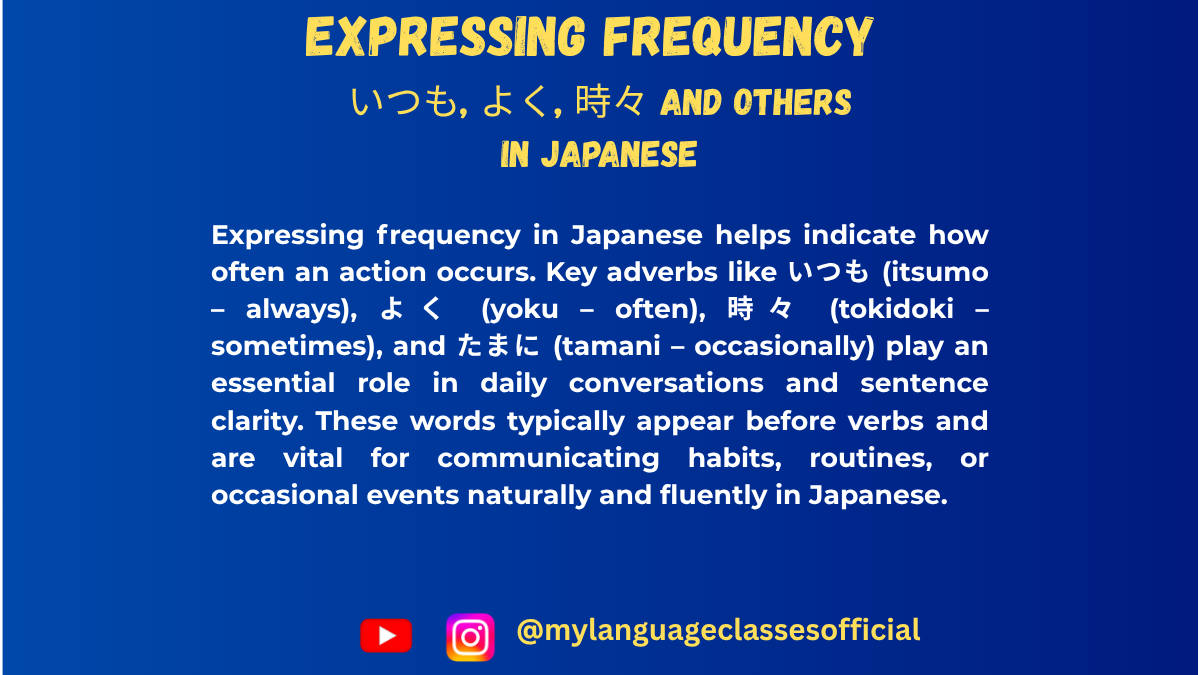
Expressing Frequency in Japanese | My Language Classes
How to Talk About Frequency in Japanese
Learning how to express frequency is an essential part of mastering any language. In Japanese, there are various ways to indicate how often something happens, ranging from daily habits to rare occurrences. This guide will provide all the patterns and tips you need to express frequency like a native speaker.
Basic Frequency Vocabulary
Here are some common adverbs used to express frequency in Japanese:
Japanese Romaji English Translation Example Sentence いつも itsumo always 私はいつも朝ごはんを食べます。
(Watashi wa itsumo asagohan o tabemasu.)
I always eat breakfast.よく yoku often 彼はよく映画を見ます。
(Kare wa yoku eiga o mimasu.)
He often watches movies.時々 tokidoki sometimes 私は時々本を読みます。
(Watashi wa tokidoki hon o yomimasu.)
I sometimes read books.たまに tamani occasionally たまに外食します。
(Tamani gaishoku shimasu.)
I occasionally eat out.あまり amari not often (with negation) 私はあまりテレビを見ません。
(Watashi wa amari terebi o mimasen.)
I don’t watch TV often.全然 zenzen never (with negation) 彼女は全然運動しません。
(Kanojo wa zenzen undou shimasen.)
She never exercises.
Patterns for Expressing Frequency
- Using Adverbs
Frequency adverbs are usually placed before the verb they modify.- Example: 私はよくカフェに行きます。
(Watashi wa yoku kafe ni ikimasu.)
I often go to cafes.
- Example: 私はよくカフェに行きます。
- Time Expressions with Frequency Indicators
To specify how often something happens, combine time expressions with frequency words like 回 (kai, “times”) or 度 (do, “times”).- Pattern:
- Time + に (ni) + Number + 回 (kai)
- Example: 一週間に三回ジムに行きます。
(Isshuukan ni sankai jimu ni ikimasu.)
I go to the gym three times a week.
- Pattern:
- Using 毎 (mai) for Recurring Activities
The prefix 毎 (mai) means “every” and is used to indicate regularity.- Examples:
- 毎日 (mainichi) – every day
- 毎週 (maishuu) – every week
- 毎月 (maigetsu/maitsuki) – every month
- 毎年 (mainen/maitoshi) – every year
- Example Sentence: 私は毎朝ジョギングをします。
(Watashi wa maiasa jogingu o shimasu.)
I jog every morning.
- Examples:
- Using ~ごとに (~goto ni)
This suffix indicates regular intervals.- Example: 二日ごとに掃除します。
(Futsuka goto ni souji shimasu.)
I clean every two days.
- Example: 二日ごとに掃除します。
- Expressing Negative Frequency
When using words like あまり (amari) or 全然 (zenzen), they must be paired with a verb in the negative form.- Examples:
- 彼はあまり勉強しません。
(Kare wa amari benkyou shimasen.)
He doesn’t study much. - 私は全然泳ぎません。
(Watashi wa zenzen oyogimasen.)
I never swim.
- 彼はあまり勉強しません。
- Examples:
Things to Keep in Mind
- Context Matters
- The frequency you use depends on the situation. For instance, using “always” (いつも) too often might make you sound exaggerated or unnatural in casual speech.
- Cultural Nuances
- Japanese people often use frequency expressions to politely imply how often they perform an action, even if it’s not true all the time. For instance, saying “よくやります” (I often do it) can sometimes serve as a polite expression rather than an exact frequency.
- Differentiating 回 (kai) and 度 (do)
- 回 (kai) is more common in casual speech, while 度 (do) can feel more formal or traditional.
- Practice Pronunciation
- Properly enunciate frequency adverbs for clarity. For instance, たまに (tamani) and 時々 (tokidoki) should not be rushed when speaking.
Practical Exercises
- Fill in the blanks with the correct frequency adverb:
- 私は(____)カラオケに行きます。
- Hint: If you go “sometimes,” use 時々.
- Translate the sentences into Japanese:
- I clean my room every week.
- He rarely eats sushi.
- Create Your Own Sentences:
- Write three sentences using different frequency adverbs. Share them with a friend or teacher for feedback!
By mastering these expressions and patterns, you’ll be well on your way to sounding natural and fluent in Japanese. Remember, practice makes perfect—so use these structures in your daily conversations and writing!
Have questions or need more practice examples? Let me know in the comments below!
If you enjoyed this lesson, be sure to check out more posts like this on my blog at My Language Classes. Don’t forget to subscribe my YouTube channel and follow me on Instagram for the latest language learning tips and lessons. Leave a comment below to share your thoughts, or ask any questions you have about nouns.
Happy learning! 😊
- Using Adverbs
-
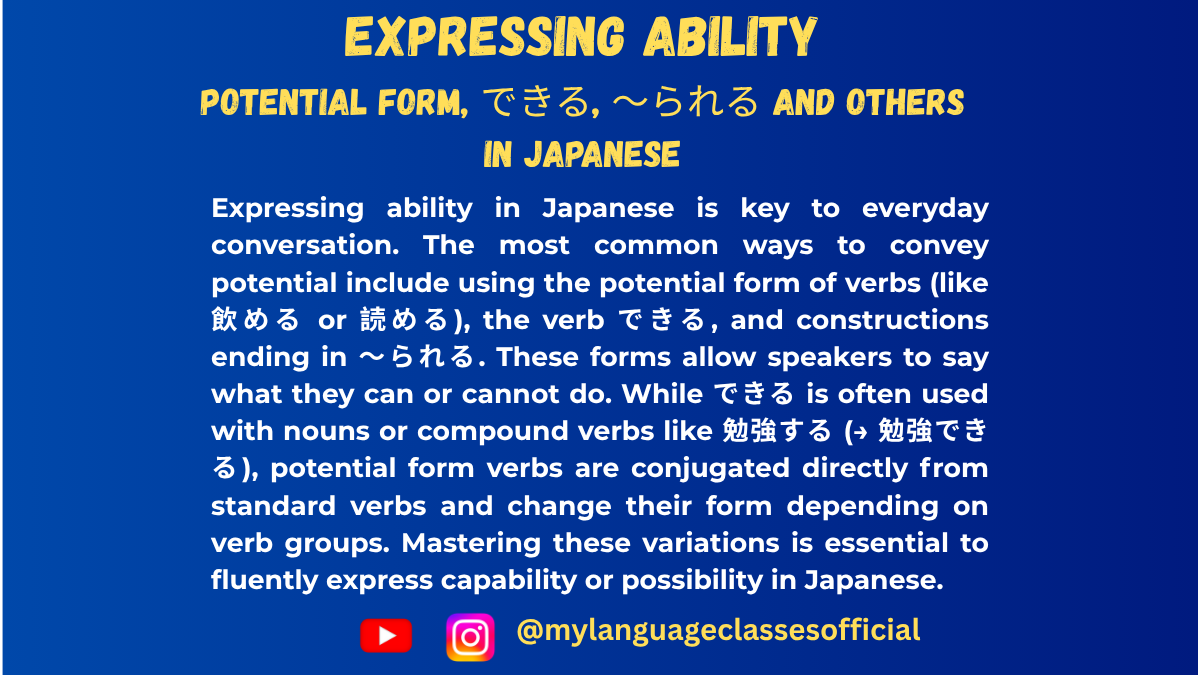
Expressing Ability in Japanese | My Language Classes
How to Express Ability in Japanese
When learning Japanese, expressing ability is an essential skill. Japanese uses specific grammatical structures to indicate whether you can do something. These expressions differ depending on the type of verb, politeness level, and context. This blog post will cover all the patterns and nuances you need to know.
1. Using Potential Form (可能形, Kanoukei)
The potential form of verbs is the most common way to express ability in Japanese. This form modifies the verb to mean “can” or “be able to.”
Formation Rules:
- Group 1 Verbs (五段動詞): Change the last “u” sound to its corresponding “e” sound and add -る.
- 書く (kaku, to write) → 書ける (kakeru, can write)
- 飲む (nomu, to drink) → 飲める (nomeru, can drink)
- Group 2 Verbs (一段動詞): Simply replace -る with -られる.
- 食べる (taberu, to eat) → 食べられる (taberareru, can eat)
- Irregular Verbs:
- する (suru, to do) → できる (dekiru, can do)
- 来る (kuru, to come) → 来られる (korareru, can come)
Usage in Sentences:
- ピアノを弾けますか? (Piano o hikemasu ka?)
Can you play the piano? - 日本語が話せます。 (Nihongo ga hanasemasu.)
I can speak Japanese.
Note: For Group 2 verbs, the shortened form 食べれる is often used in casual speech, but it may be considered grammatically incorrect in formal contexts.
2. Using the Verb できる (Dekiru)
できる is a versatile verb that expresses general ability or possibility. It is often used with nouns or “nominalized verbs” (verbs turned into nouns).
Formation Rules:
- [Noun] + ができる
- スキーができる (Sukī ga dekiru) → I can ski.
- [Verb in dictionary form] + ことができる
- 本を読むことができる (Hon o yomu koto ga dekiru) → I can read books.
Usage in Sentences:
- 私は泳ぐことができません。 (Watashi wa oyogu koto ga dekimasen.)
I cannot swim. - 新しいゲームができる。 (Atarashii geemu ga dekiru.)
I can play a new game.
Tip: Use できる for broader abilities or formal contexts, while the potential form of verbs is more direct.
3. Expressing Inability with できない and Potential Form
The negative forms of できる and potential verbs are used to express inability.
- 書けない (kakenai, cannot write)
- 飲めない (nomenai, cannot drink)
- できない (dekinai, cannot do)
Examples:
- 車を運転できません。 (Kuruma o unten dekimasen.)
I cannot drive a car. - 漢字が読めない。 (Kanji ga yomenai.)
I cannot read kanji.
4. Using Expressions with 〜られる in Daily Conversation
In casual conversation, 〜られる forms often sound softer and less assertive. You can use them to express possibilities or abilities politely.
Examples:
- この本、読めますか? (Kono hon, yomemasu ka?)
Can you read this book? - 外国語は難しいけど、頑張れば話せるよ! (Gaikokugo wa muzukashii kedo, ganbareba hanaseru yo!)
Foreign languages are hard, but you can speak them if you try!
5. Using ~ことがある to Talk About Situational Ability
You can also use ~ことがある to describe situations where something is possible or permissible.
Examples:
- 会議室を使うことができますか? (Kaigishitsu o tsukau koto ga dekimasu ka?)
Is it possible to use the meeting room? - この公園で遊ぶことができます。 (Kono kōen de asobu koto ga dekimasu.)
You can play in this park.
6. Things to Keep in Mind
- Politeness Levels:
Adjust the verb endings according to the situation. For example:- Polite: 話せます (hanasemasu)
- Casual: 話せる (hanaseru)
- Using が vs. を:
When expressing ability, the object marker changes from を to が:- ピアノを弾く → ピアノが弾ける
- Cultural Sensitivity:
Japanese speakers often avoid being overly assertive about their abilities. Phrases like ちょっと難しいです (chotto muzukashii desu, “It’s a bit difficult”) can soften the tone.
7. Practice Sentences for Learners
- 明日、山に登れますか? (Ashita, yama ni noboremasu ka?)
Can you climb the mountain tomorrow? - 子どもの時、泳ぐことができました。 (Kodomo no toki, oyogu koto ga dekimashita.)
When I was a child, I could swim. - 日本語でメールを書けますか? (Nihongo de mēru o kakemasu ka?)
Can you write an email in Japanese?
Expressing ability in Japanese can feel tricky at first, but with practice, it becomes natural. Master these forms, and you’ll be able to communicate your skills and understand others effortlessly!
Have questions or want more examples? Share them in the comments below! 🌸
If you enjoyed this lesson, be sure to check out more posts like this on my blog at My Language Classes. Don’t forget to subscribe my YouTube channel and follow me on Instagram for the latest language learning tips and lessons. Leave a comment below to share your thoughts, or ask any questions you have about nouns.
Happy learning! 😊
- Group 1 Verbs (五段動詞): Change the last “u” sound to its corresponding “e” sound and add -る.
-

Mastering Degree Words in Japanese | My Language Classes
Mastering Degree Expressions in Japanese
Degree expressions in Japanese are essential tools for describing intensity, extent, or degree of an action or quality. They are commonly used in daily conversation and writing, adding nuance and specificity to your expressions. This blog post explores patterns like とても (“very”) and あまり (“not very”) along with other degree expressions, providing details on their usage, nuances, and examples.
1. Basic Degree Expressions
とても (Totemo) – “Very”
- Usage: Used to emphasize a high degree of something.
- Structure:
とても + adjective/adverb
Example:- このケーキはとてもおいしいです。
(Kono kēki wa totemo oishii desu.)
→ This cake is very delicious. - 彼はとても速く走ります。
(Kare wa totemo hayaku hashirimasu.)
→ He runs very fast.
- このケーキはとてもおいしいです。
あまり (Amari) – “Not very” (with negative forms)
- Usage: Indicates a low degree of something and is used with negative forms of verbs or adjectives.
- Structure:
あまり + negative form of adjective/verb
Example:- あの映画はあまりおもしろくなかったです。
(Ano eiga wa amari omoshiroku nakatta desu.)
→ That movie wasn’t very interesting. - 天気はあまり良くありませんでした。
(Tenki wa amari yoku arimasen deshita.)
→ The weather wasn’t very good.
- あの映画はあまりおもしろくなかったです。
2. Other Common Degree Expressions
少し / ちょっと (Sukoshi / Chotto) – “A little”
- Usage: Indicates a small degree or extent. ちょっと is more casual than 少し.
- Structure:
少し/ちょっと + adjective/verb
Example:- 部屋は少し寒いです。
(Heya wa sukoshi samui desu.)
→ The room is a little cold. - ちょっと待ってください。
(Chotto matte kudasai.)
→ Please wait a moment.
- 部屋は少し寒いです。
かなり / 相当 (Kanari / Sōtō) – “Quite/Considerably”
- Usage: Indicates a significant degree, but less than とても.
- Structure:
かなり/相当 + adjective/adverb
Example:- この問題はかなり難しいです。
(Kono mondai wa kanari muzukashii desu.)
→ This problem is quite difficult. - 彼は相当疲れているようです。
(Kare wa sōtō tsukarete iru yō desu.)
→ He seems considerably tired.
- この問題はかなり難しいです。
非常に (Hijō ni) – “Extremely”
- Usage: Formal and strong degree expression, often used in written or formal contexts.
- Structure:
非常に + adjective/adverb
Example:- このテクノロジーは非常に有用です。
(Kono tekunorojī wa hijō ni yūyō desu.)
→ This technology is extremely useful.
- このテクノロジーは非常に有用です。
3. Nuanced Degree Expressions
そんなに (Sonna ni) – “So much” (with negative)
- Usage: Typically used in negative contexts to downplay something.
- Structure:
そんなに + negative form
Example:- この宿題はそんなに難しくありません。
(Kono shukudai wa sonna ni muzukashiku arimasen.)
→ This homework isn’t so difficult.
- この宿題はそんなに難しくありません。
めっちゃ / 超 (Meccha / Chō) – “Super” (Informal)
- Usage: Extremely casual and common in spoken Japanese, especially among younger people.
- Structure:
めっちゃ/超 + adjective
Example:- この店のラーメン、超うまい!
(Kono mise no rāmen, chō umai!)
→ The ramen at this place is super delicious! - 昨日はめっちゃ楽しかった。
(Kinō wa meccha tanoshikatta.)
→ Yesterday was super fun.
- この店のラーメン、超うまい!
4. Expressing Extremes
一番 (Ichiban) – “The most”
- Usage: Indicates the highest degree or rank.
- Structure:
一番 + adjective/adverb
Example:- 富士山は日本で一番高い山です。
(Fujisan wa Nihon de ichiban takai yama desu.)
→ Mount Fuji is the tallest mountain in Japan.
- 富士山は日本で一番高い山です。
最高に (Saikō ni) – “The best/most”
- Usage: Used to express the peak level of a positive quality.
- Structure:
最高に + adjective
Example:- 今日は最高に幸せです。
(Kyō wa saikō ni shiawase desu.)
→ I’m the happiest today.
- 今日は最高に幸せです。
5. Things to Keep in Mind
- Context Matters:
- Use formal expressions like 非常に in professional or academic settings.
- Opt for casual expressions like めっちゃ in informal conversations.
- Politeness Levels:
Adjust your degree expressions depending on who you are speaking to. For instance, avoid めっちゃ with your boss, and use とても or かなり instead. - Avoid Overusing:
Overloading sentences with degree expressions can make your speech sound unnatural. Be selective and intentional. - Negative Nuances:
Expressions like あまり and そんなに are inherently tied to negativity. Ensure you pair them with negative predicates.
6. Practice Makes Perfect
The best way to master degree expressions is through regular practice. Try using these patterns in daily conversation or writing. Listen to native speakers in dramas, anime, or news to observe how these expressions are naturally applied.
By incorporating these degree expressions into your Japanese language practice, you’ll develop a richer and more nuanced ability to communicate, allowing you to better convey your thoughts and feelings. Happy learning!
If you enjoyed this lesson, be sure to check out more posts like this on my blog at My Language Classes. Don’t forget to subscribe my YouTube channel and follow me on Instagram for the latest language learning tips and lessons. Leave a comment below to share your thoughts, or ask any questions you have about nouns.
Happy learning! 😊
-
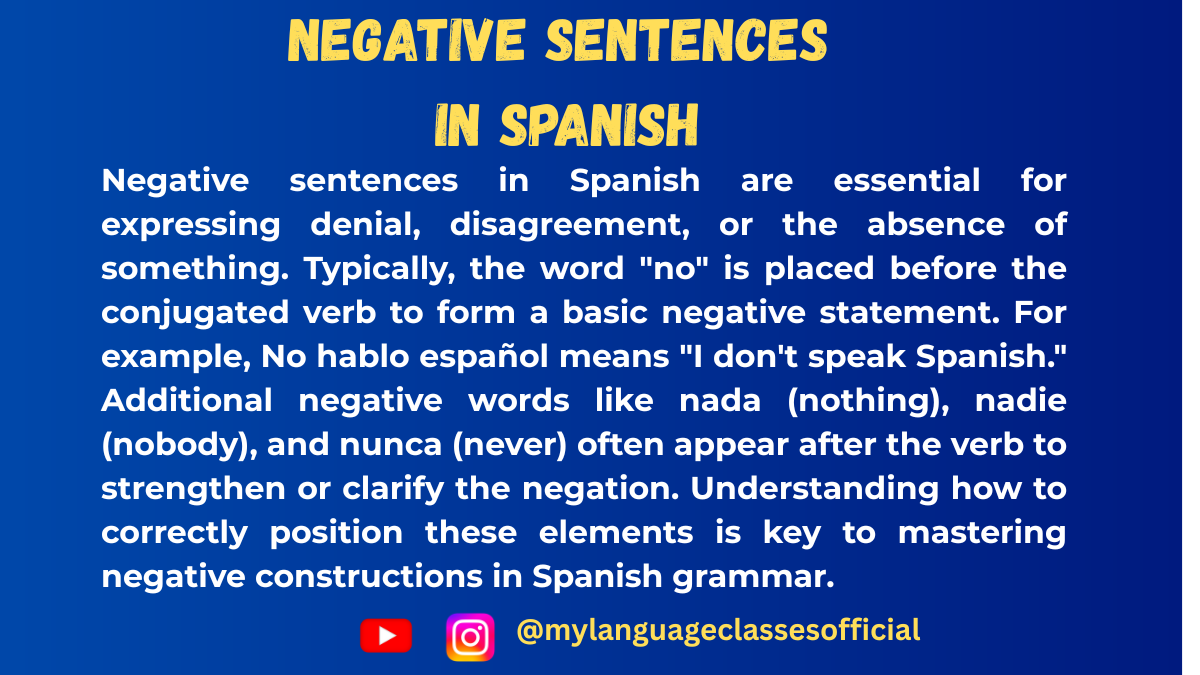
Negative Sentences in Spanish
When learning Spanish, mastering negative sentences is essential for effective communication. Negative sentences allow you to deny, contradict, or express the absence of something. This blog post will guide you through the rules, structures, and common considerations when constructing negative sentences in Spanish, including gender, articles, and plurals.
Basic Structure of Negative Sentences
In Spanish, the word “no” is the key to forming negative sentences. It is placed before the verb.
Examples:
- Affirmative: María canta bien. (María sings well.)
- Negative: María no canta bien. (María does not sing well.)
The structure is straightforward:
Subject + “no” + verb + complement.
Using Negative Words
In Spanish, additional negative words reinforce or replace “no.” These include:
- nada (nothing)
- nadie (nobody)
- ningún/ninguno/ninguna (none, no one)
- nunca (never)
- tampoco (neither)
Double Negatives
Unlike English, double negatives are not only acceptable but required in Spanish. For instance:
- No veo nada. (I don’t see anything.)
- No conozco a nadie. (I don’t know anyone.)
- No estudio nunca. (I never study.)
Here, “no” works in harmony with other negative words.
Gender and Plural Considerations
1. Gender Agreement
Negative words like ninguno and ninguna must agree with the gender of the noun they modify.
- Masculine singular:
No tengo ningún problema. (I don’t have any problem.) - Feminine singular:
No tengo ninguna idea. (I don’t have any idea.)
2. Plural Agreement
In most cases, ninguno is not pluralized, except in specific cases like inherently plural nouns:
- No tengo ningunas vacaciones este año. (I don’t have any vacations this year.)
Position of Negative Words
1. Before the Verb
Negative words like “no” are typically placed before the verb:
- No quiero comer. (I don’t want to eat.)
2. After the Verb
Other negative words may follow the verb for emphasis:
- No quiero nada. (I don’t want anything.)
If a subject pronoun is omitted (common in Spanish), pay attention to word order:
- Nadie sabe la respuesta. (Nobody knows the answer.)
Common Mistakes to Avoid
- Forgetting Double Negatives
Avoid translating English structures directly. Saying No sé algo instead of No sé nada is incorrect. - Ignoring Gender and Number Agreement
Ensure that words like ninguno/ninguna match the noun’s gender and number. - Mixing Articles Incorrectly
When using negative words, omit definite articles unless emphasizing specificity:
- Incorrect: No tengo la idea.
- Correct: No tengo idea.
Practical Tips
- Practice with Examples
Write affirmative and negative versions of sentences:
- Ella siempre llega a tiempo. (She always arrives on time.)
- Ella nunca llega a tiempo. (She never arrives on time.)
- Use Context to Choose Negative Words
- Use nada for “nothing” or “anything.”
- Use nadie when referring to “nobody” or “anybody.”
- Practice Conversations
Create scenarios to apply double negatives naturally:
- No tengo nada que decir. (I have nothing to say.)
Mastering negative sentences in Spanish opens up new possibilities for nuanced communication. Practice regularly, pay attention to gender and number agreement, and soon, negatives will become second nature.
¡Buena suerte! (Good luck!)
If you enjoyed this lesson, be sure to check out more posts like this on my blog at My Language Classes. Don’t forget to subscribe my YouTube channel and follow me on Instagram for the latest language learning tips and lessons. Leave a comment below to share your thoughts, or ask any questions you have.
Happy learning! 😊
-
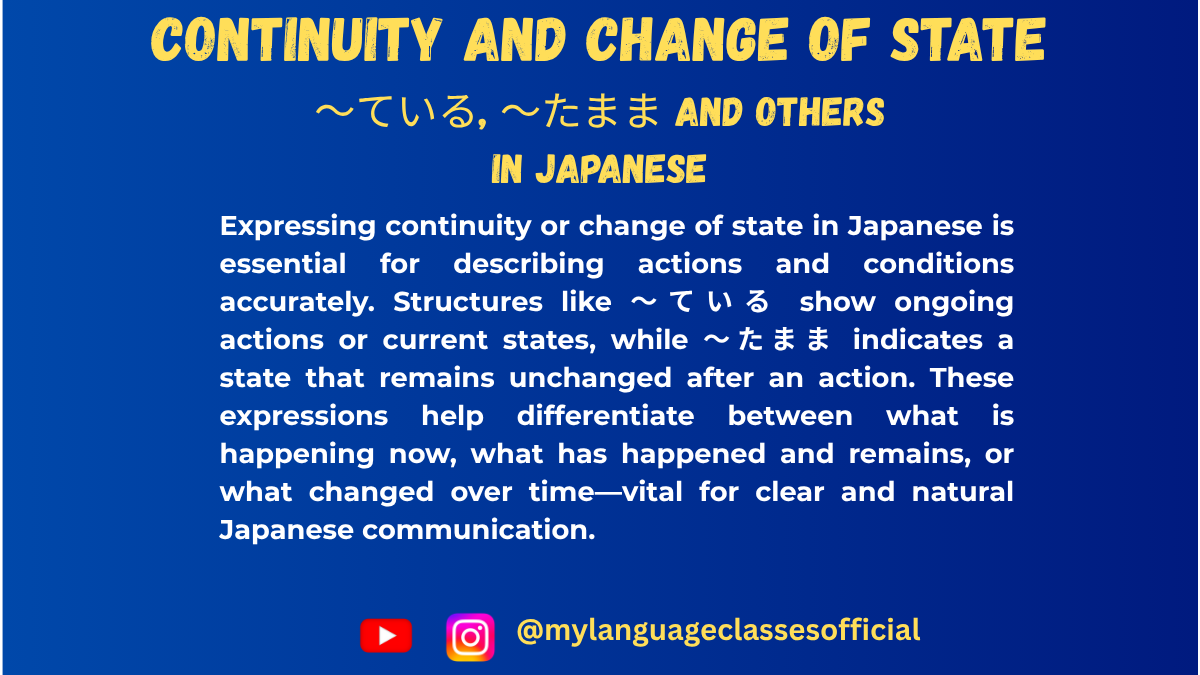
How to Show Continuity in Japanese | My Language Classes
Expressing Continuity or Change of State in Japanese
In Japanese, understanding how to express ongoing actions, states, or transitions is essential for achieving fluency. These expressions allow speakers to describe actions in progress, habitual actions, or states resulting from actions. In this blog, we’ll dive into various patterns to express continuity or a change of state, starting with the well-known Verb て-form + いる, and expanding into other structures and nuances.
1. Verb て-form + いる (~ている)
Usage:
- Continuous Action: Indicates an action currently in progress.
- Example:
- 本を読んでいる。
(Hon o yonde iru.)
“I am reading a book.”
- 本を読んでいる。
- Example:
- Resultant State: Refers to the state resulting from an action.
- Example:
- ドアが開いている。
(Doa ga aite iru.)
“The door is open.” (The action of opening has occurred, and the state is ongoing.)
- ドアが開いている。
- Example:
- Habitual Action: Expresses something done regularly or habitually.
- Example:
- 毎朝ジョギングをしている。
(Maiasa jogingu o shite iru.)
“I jog every morning.”
- 毎朝ジョギングをしている。
- Example:
Points to Keep in Mind:
- The context determines whether it refers to an ongoing action, a resultant state, or a habitual action.
- In casual speech, いる is often contracted to る or omitted entirely. For example:
- 読んでる instead of 読んでいる.
2. Verb Stem + 続ける (~つづける)
This pattern expresses the idea of continuing an action without stopping.
Usage:
- Continuous Action: Indicates persistence or continuity of an action.
- Example:
- 彼は勉強し続ける。
(Kare wa benkyou shi tsuzukeru.)
“He continues to study.”
- 彼は勉強し続ける。
- Example:
Points to Keep in Mind:
- The verb 続ける (to continue) can also be conjugated, e.g., 続けます (formal), 続けた (past tense).
- This structure emphasizes effort or intention behind continuity.
3. Verb た-form + まま
This structure expresses the idea of a state being left unchanged.
Usage:
- Unchanged State: Indicates that something remains in its current state.
- Example:
- 靴を履いたまま部屋に入らないでください。
(Kutsu o haita mama heya ni hairanaide kudasai.)
“Please don’t enter the room with your shoes on.”
- 靴を履いたまま部屋に入らないでください。
- Example:
Points to Keep in Mind:
- The subject must remain in the state expressed by the verb.
- Often used to highlight an undesirable or unintended state.
4. Noun + のまま
Similar to the verb usage, this pattern expresses an unchanged state with nouns.
Usage:
- Unchanged State: Describes a situation where something stays the same.
- Example:
- 冷たい飲み物のまま飲んだ。
(Tsumetai nomimono no mama nonda.)
“I drank it while it was still cold.”
- 冷たい飲み物のまま飲んだ。
- Example:
5. Verb Base + ながら
The ~ながら form allows for the expression of two simultaneous actions.
Usage:
- Simultaneous Actions: Describes doing one action while performing another.
- Example:
- 音楽を聴きながら勉強する。
(Ongaku o kikinagara benkyou suru.)
“I study while listening to music.”
- 音楽を聴きながら勉強する。
- Example:
Points to Keep in Mind:
- The main focus is usually on the action described by the main clause.
- Both actions must involve the same subject.
6. Adjective + まま
Describes a state where something remains as it is, often with adjectives.
Usage:
- Unchanged Condition:
- Example:
- 暑いままで寝てしまった。
(Atsui mama de nete shimatta.)
“I fell asleep while it was still hot.”
- 暑いままで寝てしまった。
- Example:
7. Verb て-form + いく / Verb て-form + くる
These forms express a change of state over time or movement.
Usage:
- ~ていく: Indicates a progression away from the present or current state.
- Example:
- 暗くなっていく。
(Kuraku natte iku.)
“It’s getting darker.”
- 暗くなっていく。
- Example:
- ~てくる: Indicates a progression towards the present or a return to the current state.
- Example:
- 涼しくなってきた。
(Suzushiku natte kita.)
“It has started to become cool.”
- 涼しくなってきた。
- Example:
Points to Keep in Mind:
- These forms are particularly useful for describing gradual or dynamic changes.
8. Verb Stem + 出す / Verb Stem + 始める
Both patterns describe the initiation of an action or state.
Usage:
- ~出す: Indicates a sudden or spontaneous beginning of an action.
- Example:
- 赤ちゃんが泣き出した。
(Akachan ga nakidashita.)
“The baby started crying.”
- 赤ちゃんが泣き出した。
- Example:
- ~始める: Describes the commencement of an action.
- Example:
- 本を読み始める。
(Hon o yomihajimeru.)
“I start reading a book.”
- 本を読み始める。
- Example:
Points to Keep in Mind:
- 出す suggests a more abrupt or unexpected start, while 始める implies a deliberate beginning.
Final Thoughts:
When discussing continuity or a change of state in Japanese, understanding the nuances of these patterns is crucial. The choice of expression depends on context, intent, and the subtleties of the situation being described. Here are some key points to remember:
- Context is king: Be mindful of whether you’re describing an ongoing action, a habitual action, or a resultant state.
- Nuance matters: Patterns like ~ていく and ~てくる convey subtle differences in directionality or emotional tone.
- Practice in context: Try creating sentences using each pattern to internalize their meanings and usage.
By mastering these structures, you can convey complex temporal and state-related concepts in Japanese with clarity and precision. Happy learning! 😊
If you enjoyed this lesson, be sure to check out more posts like this on my blog at My Language Classes. Don’t forget to subscribe my YouTube channel and follow me on Instagram for the latest language learning tips and lessons. Leave a comment below to share your thoughts, or ask any questions you have about nouns.
Happy learning! 😊
- Continuous Action: Indicates an action currently in progress.
-
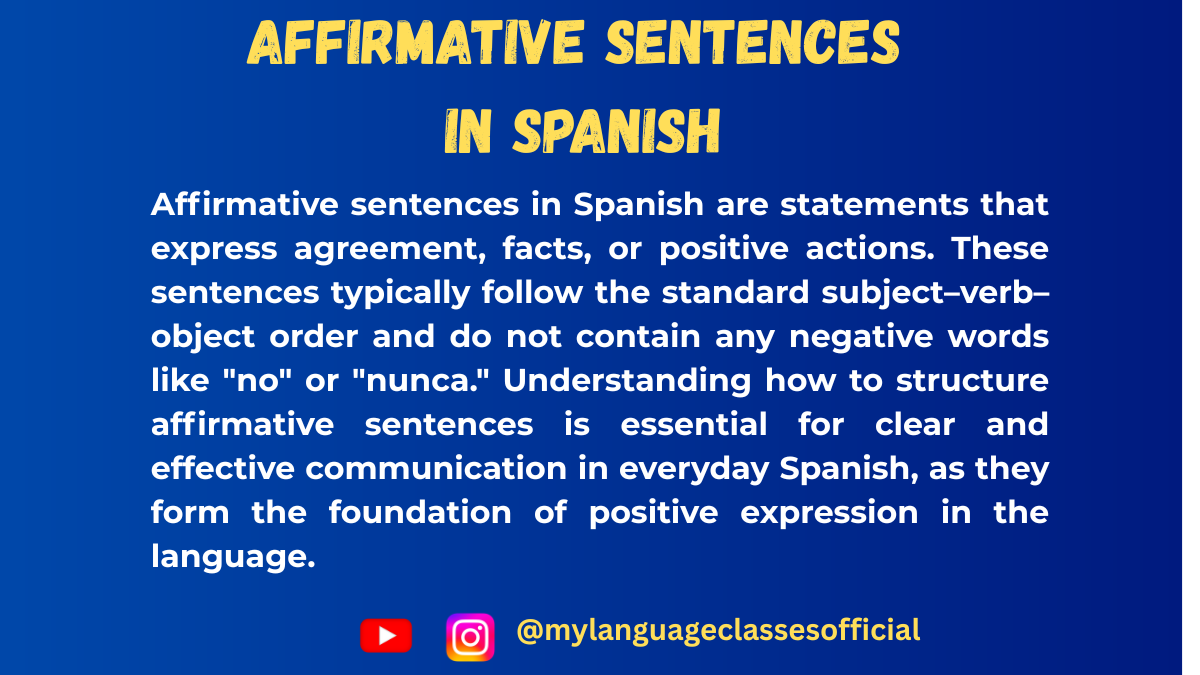
Affirmative Sentences in Spanish
Affirmative sentences in Spanish are the backbone of everyday communication. They help you convey basic facts, express opinions, and share information. In this blog post, we’ll break down the structure of affirmative sentences, explore key grammar rules, and cover essential points related to gender, pluralization, and the use of articles.
What Are Affirmative Sentences?
Affirmative sentences are straightforward statements that assert or affirm something. For example:
- Yo tengo un perro. (I have a dog.)
- Ellos están felices. (They are happy.)
These sentences contrast with negative sentences (No tengo un perro) and questions (¿Tienes un perro?).
Basic Structure of Affirmative Sentences
In Spanish, the standard sentence structure follows this order:
Subject + Verb + ComplementExamples:
- Ella canta una canción. (She sings a song.)
- Nosotros leemos libros en la biblioteca. (We read books in the library.)
Although Spanish word order can sometimes be flexible for stylistic reasons, this is the default format.
Key Grammar Points for Affirmative Sentences
1. Gender and Number Agreement
In Spanish, nouns and adjectives must agree in gender (masculine/feminine) and number (singular/plural).
- Masculine nouns often end in -o (e.g., niño – boy) and feminine nouns in -a (e.g., niña – girl).
- Adjectives also change based on gender and number.
- Singular: El perro negro (The black dog).
- Plural: Los perros negros (The black dogs).
2. Use of Definite and Indefinite Articles
Articles are essential in Spanish affirmative sentences.
- Definite Articles (the):
- Singular: el (masculine), la (feminine)
- Plural: los (masculine), las (feminine)
Example: El libro está en la mesa. (The book is on the table.)
- Indefinite Articles (a, an, some):
- Singular: un (masculine), una (feminine)
- Plural: unos (masculine), unas (feminine)
Example: Tengo una idea. (I have an idea.)
3. Regular vs. Irregular Verbs
Verbs in Spanish can be regular or irregular. Pay attention to conjugation based on the subject.
- Regular verb example:
Yo hablo español. (I speak Spanish.) - Irregular verb example:
Ella tiene un hermano. (She has a brother.)
4. Pronoun Usage
In Spanish, subject pronouns (yo, tú, él/ella, nosotros, vosotros, ellos/ellas) are often optional. The verb conjugation usually makes the subject clear.
- Yo como manzanas. = Como manzanas. (I eat apples.)
Examples of Affirmative Sentences in Context
Here’s how affirmative sentences work with different grammatical rules:
- Singular and Plural
- Singular: El niño juega en el parque. (The boy plays in the park.)
- Plural: Los niños juegan en el parque. (The boys play in the park.)
- Gender Agreement
- Masculine: Un profesor simpático enseña la clase. (A nice professor teaches the class.)
- Feminine: Una profesora simpática enseña la clase. (A nice female professor teaches the class.)
- Verb Conjugations
- Regular: Nosotros aprendemos español. (We learn Spanish.)
- Irregular: Yo voy al supermercado. (I go to the supermarket.)
- Complex Sentences
- Ellos están comiendo en el restaurante italiano. (They are eating at the Italian restaurant.)
Tips for Forming Affirmative Sentences
- Practice Verb Conjugations: Learn the present tense conjugation of regular verbs (-ar, -er, -ir) and memorize irregular ones.
- Master Articles and Agreement: Always match articles and adjectives with the gender and number of the noun.
- Expand Vocabulary: Build your vocabulary with common nouns, adjectives, and verbs to create diverse sentences.
- Practice Speaking: Use affirmative sentences in daily conversations to build fluency.
Common Mistakes to Avoid
- Skipping Gender and Number Agreement:
- Incorrect: La casa blancos.
- Correct: La casa blanca.
- Incorrect Article Usage:
- Incorrect: Un agua fría.
- Correct: Una agua fría. (Water is feminine, even though it begins with a stressed “a.”)
- Overusing Pronouns:
- Not necessary: Yo voy al cine.
- Better: Voy al cine.
Practice Exercises
- Convert these phrases to plural:
- El gato está en la casa.
- Una flor roja decora la mesa.
- Match the adjective to the noun:
- El coche (rojo/roja).
- Las niñas (inteligentes/inteligente).
- Conjugate the verb:
- Nosotros (hablar) español.
- Ella (comer) una manzana.
Conclusion
Understanding affirmative sentences is crucial for building confidence in Spanish. By mastering the rules of sentence structure, verb conjugations, and gender and number agreement, you’ll be well on your way to expressing yourself clearly and fluently.
Practice regularly, and don’t hesitate to immerse yourself in conversations or writing exercises. ¡Buena suerte! (Good luck!)
If you enjoyed this lesson, be sure to check out more posts like this on my blog at My Language Classes. Don’t forget to subscribe my YouTube channel and follow me on Instagram for the latest language learning tips and lessons. Leave a comment below to share your thoughts, or ask any questions you have.
Happy learning! 😊
-
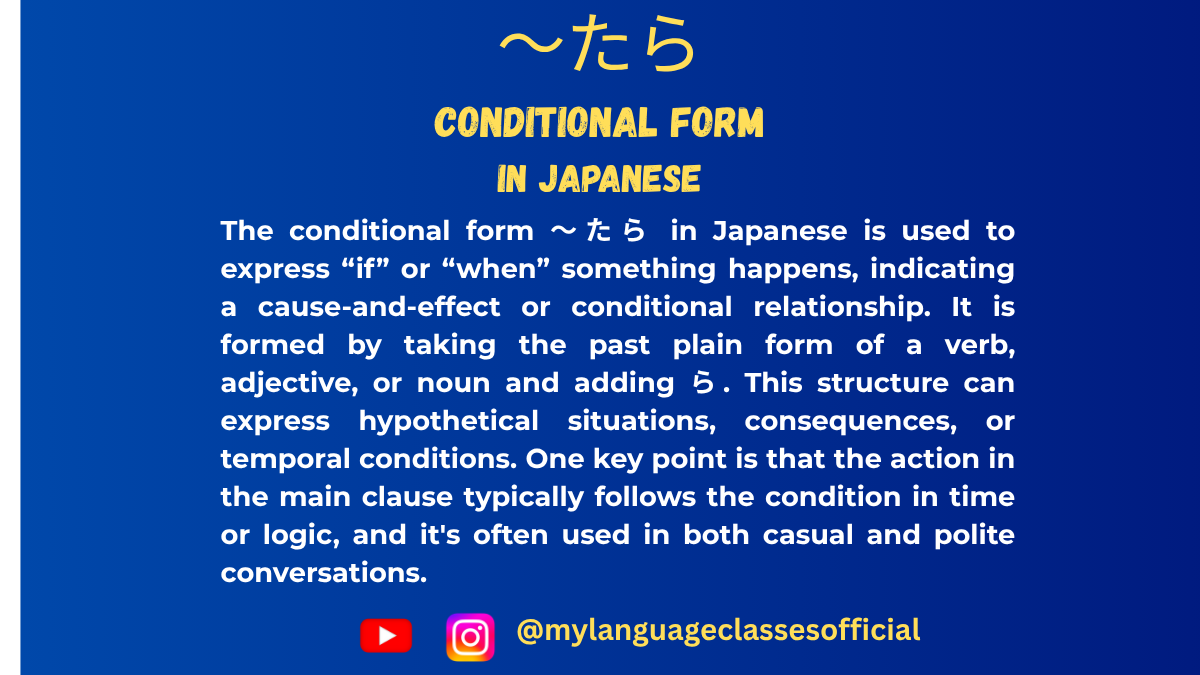
Understanding Conditional form ~たら in Japanese | My Language Classes
Understanding ~たら in Japanese
Learning Japanese grammar often feels like solving a puzzle, where each piece contributes to your fluency. One such critical piece is the ~たら structure, a conditional form that translates roughly to “if” or “when” in English. In this blog post, we’ll break down how to use ~たら effectively, covering its structure, usage, and nuances, along with examples to boost your confidence.
What is ~たら?
The ~たら structure comes from the past tense form of a verb, adjective, or noun, combined with ら (ra). It’s used to express conditional situations, which means it helps us talk about “if” or “when” something happens.
Key Functions of ~たら:
- Expressing Conditions: “If X happens, then Y will occur.”
- Temporal Sense: “When X happens, Y will follow.”
This dual meaning is a hallmark of ~たら, and context determines whether it means “if” or “when.”
The Structure of ~たら
Let’s look at how to form ~たら for different word types:
1. Verbs
- Take the plain past tense form (た-form) of the verb + ら.
- Example:
食べる → 食べた → 食べたら (if/when [I] eat)
2. Adjectives
- For い-adjectives, replace the final い with かったら.
- Example: 高い → 高かった → 高かったら (if/when [it’s] expensive)
- For な-adjectives, use the structure: adjective + だったら.
- Example: 静か → 静かだったら (if/when [it’s] quiet)
3. Nouns
- Combine the noun with だったら.
- Example: 休み → 休みだったら (if/when [it’s] a holiday)
Usage Examples
Let’s explore ~たら in action, both as “if” and “when.”
1. Conditional “If”
- 日本に行ったら、寿司を食べたいです。
(Nihon ni ittara, sushi o tabetai desu.)
If I go to Japan, I want to eat sushi. - 時間があったら、映画を見ましょう。
(Jikan ga attara, eiga o mimashou.)
If we have time, let’s watch a movie.
Here, the meaning hinges on a hypothetical condition being met.
2. Temporal “When”
- 家に帰ったら、宿題をします。
(Ie ni kaettara, shukudai o shimasu.)
When I get home, I’ll do my homework. - 雨がやんだら、公園で遊びましょう。
(Ame ga yandara, kouen de asobimashou.)
When the rain stops, let’s play at the park.
In these examples, ~たら conveys a temporal relationship, emphasizing a sequence of events.
Nuances and Tips
- Avoid Overlapping ~たら with ~と or ~ば
While ~と and ~ば also express conditions, ~たら is more versatile because it handles both “if” and “when.” However, ~と is more deterministic (e.g., water boils when heated), and ~ば can feel more formal or speculative. - Expressing Surprise or Discovery
~たら is also used to convey unexpected results:- ドアを開けたら、猫がいました。
(Doa o aketara, neko ga imashita.)
When I opened the door, there was a cat.
Here, the speaker did not anticipate finding a cat.
- ドアを開けたら、猫がいました。
- Avoid Using ~たら for Certainties
If an event is guaranteed to occur (e.g., the sun rising), use a temporal marker like ~時 instead of ~たら.
Practice Time!
Try making your own sentences using ~たら. Here are some prompts to get you started:
- What would you do if you won the lottery?
宝くじに当たったら、______。 - What will you do when the weekend comes?
週末になったら、______。
Share your answers in the comments or with your language partner. Practice makes perfect!
Final Thoughts
The ~たら structure is a cornerstone of Japanese conditional grammar. By mastering it, you’ll unlock the ability to express complex ideas about possibilities and sequences. Remember to pay attention to context to distinguish between “if” and “when,” and don’t hesitate to experiment with it in your conversations.
Ready to elevate your Japanese skills? Try using ~たら today!
If you enjoyed this lesson, be sure to check out more posts like this on my blog at My Language Classes. Don’t forget to subscribe my YouTube channel and follow me on Instagram for the latest language learning tips and lessons. Leave a comment below to share your thoughts, or ask any questions you have about nouns.
Happy learning! 😊

